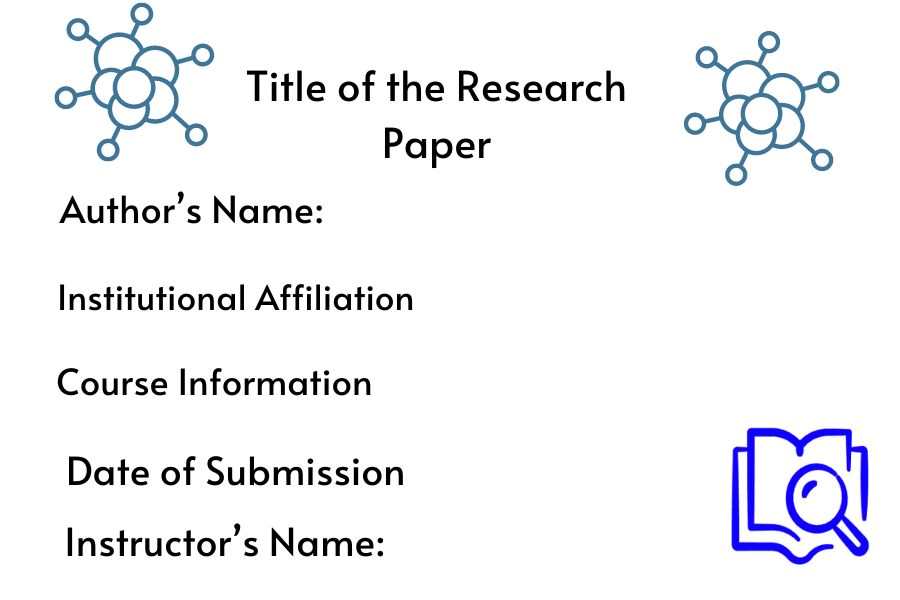Last updated on July 8th, 2025 at 06:15 am
A research paper cover page may seem like a trivial detail, but it is far from insignificant. This first page is the gateway to your research paper, providing essential details and establishing the paper’s tone.
It’s a vital part of your academic presentation that shouldn’t be underestimated.
Table of Contents
What is a Research Paper Cover Page?
A research paper cover page, often called a title page, is the opening page that contains key information about the paper. It usually includes the title of the work, the author’s name, institutional affiliation, course information, and the date of submission.
This page serves both as an identifier and a formal introduction to the content within.
Why is the cover page important?
A well-constructed cover page does more than just list facts. It establishes credibility, showcases your adherence to academic standards, and provides a first impression.
Following prescribed formatting guidelines, whether APA, MLA, or Chicago style, ensures uniformity and demonstrates respect for the academic community.
Key Elements of a Research Paper Cover Page Examples
Title of the Research Paper: Clear and descriptive, reflecting the core of your research.
Author’s Name: Your full name, as registered with the institution.
Institutional Affiliation: The name of your university or college.
Course Information: Course name and number, if applicable.
Date of Submission: The exact date you submit the paper.
Instructor’s Name: Include only if required by your instructor or institution.
Formatting Styles and Their Requirements
Each academic discipline often adheres to a specific style, like APA, MLA, or Chicago, among several others. Each has unique guidelines for cover pages.
APA Style:
APA, popular in psychology and social sciences, requires a specific format with a running head, paper title, author name, and institutional affiliation centered on the page.
APA Style Cover Page Example
The APA cover page is centered with all text double-spaced. The title should be in title case, bold, and located halfway down the page. Your name and institution appear directly beneath.
MLA Style:
MLA, commonly used in the humanities, does not typically require a cover page, but when it does, it’s relatively straightforward with the title, your name, instructor’s name, course, and date.
MLA Style Cover Page Example
MLA’s cover page is simplistic and neat. All text is left-aligned, with the title of the paper centered on the page.
Chicago Style:
Chicago style, preferred in history and some social sciences, often demands a more detailed cover page that includes the title, subtitle, author’s name, and other pertinent details.
Chicago Style Cover Page Example
Chicago style provides more flexibility but typically includes a centered title halfway down, with your name and other details near the bottom.
Common Mistakes to Avoid on a Cover Page
Avoid overcrowding your cover page with unnecessary elements, incorrect fonts, or omitted details. Always adhere to the style guide prescribed by your instructor or institution.
Tips for Designing an Effective Cover Page
Strive for simplicity while including all required details. Use professional fonts like Times New Roman or Arial and appropriate font sizes.
Customizing Cover Pages for Different Academic Levels
The requirements for cover pages can vary based on the level of study. For instance, a PhD dissertation might include more details, such as committee names and more comprehensive affiliations.
Using Templates for Quick and Accurate Formatting
Templates can save time and ensure your formatting adheres to specific style guidelines. Microsoft Word and Google Docs offer several templates.
How to Create a Cover Page in Microsoft Word
Open Word, choose “Cover Page” from the “Insert” tab, and select a suitable template. Customize it to suit your requirements.
Creating a Cover Page in Google Docs
Navigate to “File,” select “New,” and then “From template gallery.” Pick a cover page template and modify it accordingly.

Best Practices for Research Paper Cover Pages
Consistency is key. Keep your formatting uniform throughout the document, and always double-check the information on the cover page for accuracy.
Instructor or Institution-Specific Guidelines
Always consult your instructor or institution for specific requirements or preferences that might override general guidelines.
Visual Examples of Research Paper Cover Pages
Look at multiple examples to understand various styles and select elements that best suit your paper’s requirements.
Seeing real-life examples can help solidify your understanding of proper cover page formats.
FAQs
What should be included on a research paper cover page?
A research paper cover page should typically include the title of the paper, the author’s name, institutional affiliation, course information, date of submission, and sometimes the instructor’s name, depending on the required formatting style (e.g., APA, MLA, Chicago).
How do you format a cover page in APA style?
In APA style, a cover page should have a running head at the top, the paper title centered in bold in the upper half of the page, followed by the author’s name and institutional affiliation. The title should be in the title case, and all text should be double-spaced.
Is a cover page necessary for a research paper?
The necessity of a cover page depends on the specific requirements set by your instructor, institution, or the formatting style you are using. While APA style requires a cover page, MLA style typically does not, unless specifically requested.
Conclusion
Crafting a proper cover page for your research paper is more than just a formality; it’s a crucial step in ensuring your work is taken seriously. A well-formatted cover page adheres to guidelines, establishes credibility, and creates a strong first impression. Don’t neglect this important component of academic writing.




